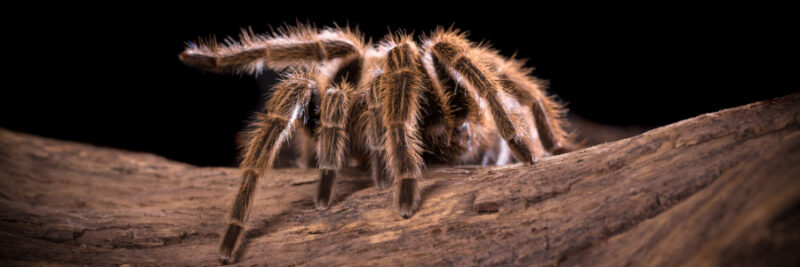Introduction to Pet Tarantulas
Hey there, future tarantula keepers! Welcome to the intriguing world of tarantulas. These eight-legged creatures are not just a marvel of nature but also an incredible foray into exotic pet care. Whether you’re drawn by their mysterious demeanor or fascinated by their unique biology, caring for a tarantula can be an enriching experience.
Habitat Design

Enclosure Size
The first step in tarantula care is setting up the right home. A 5 to 10-gallon tank works well for most species, but size can vary based on the tarantula’s type and size. Remember, more space isn’t always better – too large an enclosure can make food hunting difficult for your pet.
Ambient Environment
Tarantulas need a specific environment to thrive. Temperature and humidity are crucial – most species prefer temperatures in the 75-85°F range and humidity levels between 50-70%. Heating pads and humidity gauges can help maintain these conditions. But be careful not to overdo it, as extreme conditions can harm your spider.
Interior Decor & Substrate
Let’s make your tarantula’s house a home. A layer of substrate like coconut fiber, peat moss, or vermiculite about 2-4 inches deep is ideal for burrowing species. Include hiding spots like hollow logs or cork bark. Remember, the enclosure should be escape-proof but still allow proper ventilation.
Species Selection
Starter Tarantulas
Not all tarantulas are suitable for beginners. Species like the Chilean Rose (Grammostola rosea) and the Mexican Redknee (Brachypelma smithi) are known for their docile nature and simpler care requirements, making them great for starters.
Spiderling Care
Raising a spiderling is both challenging and rewarding. They require smaller enclosures and more frequent feeding. It’s a commitment, but watching your spiderling grow can be a fascinating process.
Handling & Interacting

Safe Handling Etiquette
While some tarantulas tolerate occasional gentle handling, always approach with caution. Slow and steady movements are key. Remember, tarantulas are more fragile than they look – a fall from even a small height can be fatal.
Allowing Adjustment
New tarantulas need time to adjust to their new environment. It’s common for them to hide or refuse food initially. Give them space and time to acclimate without unnecessary stress.
Health & Hydration
Hydration Accessories
A shallow water dish is essential in your tarantula’s enclosure. Ensure it’s not too deep to prevent drowning hazards. For smaller spiderlings, a sponge soaked in water can be used.
Monitoring Health
Regular observation is key to ensuring your tarantula’s health. Signs of distress include lack of appetite, lethargy, or visible injuries. Molting can also be a stressful time for tarantulas and requires special care.
FAQ about Starting with Tarantulas
The essentials include an appropriate-sized enclosure, substrate, hide, water dish, and temperature/humidity monitoring tools. Research your specific species for any additional requirements.
While tarantulas are relatively low-maintenance compared to other pets, they have specific environmental and dietary needs that must be met for their well-being.
Approach with calmness and caution. Use gentle movements, and avoid sudden actions that could startle the tarantula. Handling should always be minimal to reduce stress.
Tarantulas don’t have the same capacity for enjoyment from being held as other pets might. They tolerate handling rather than enjoy it. Always prioritize the tarantula's comfort and safety.

This guide is your starting point into the captivating world of tarantula care. With patience and attention to detail, you’ll not only ensure the well-being of your new pet but also discover the joys and wonders of keeping these remarkable creatures. Enjoy the journey into tarantula parenthood – it’s a unique and rewarding experience!
